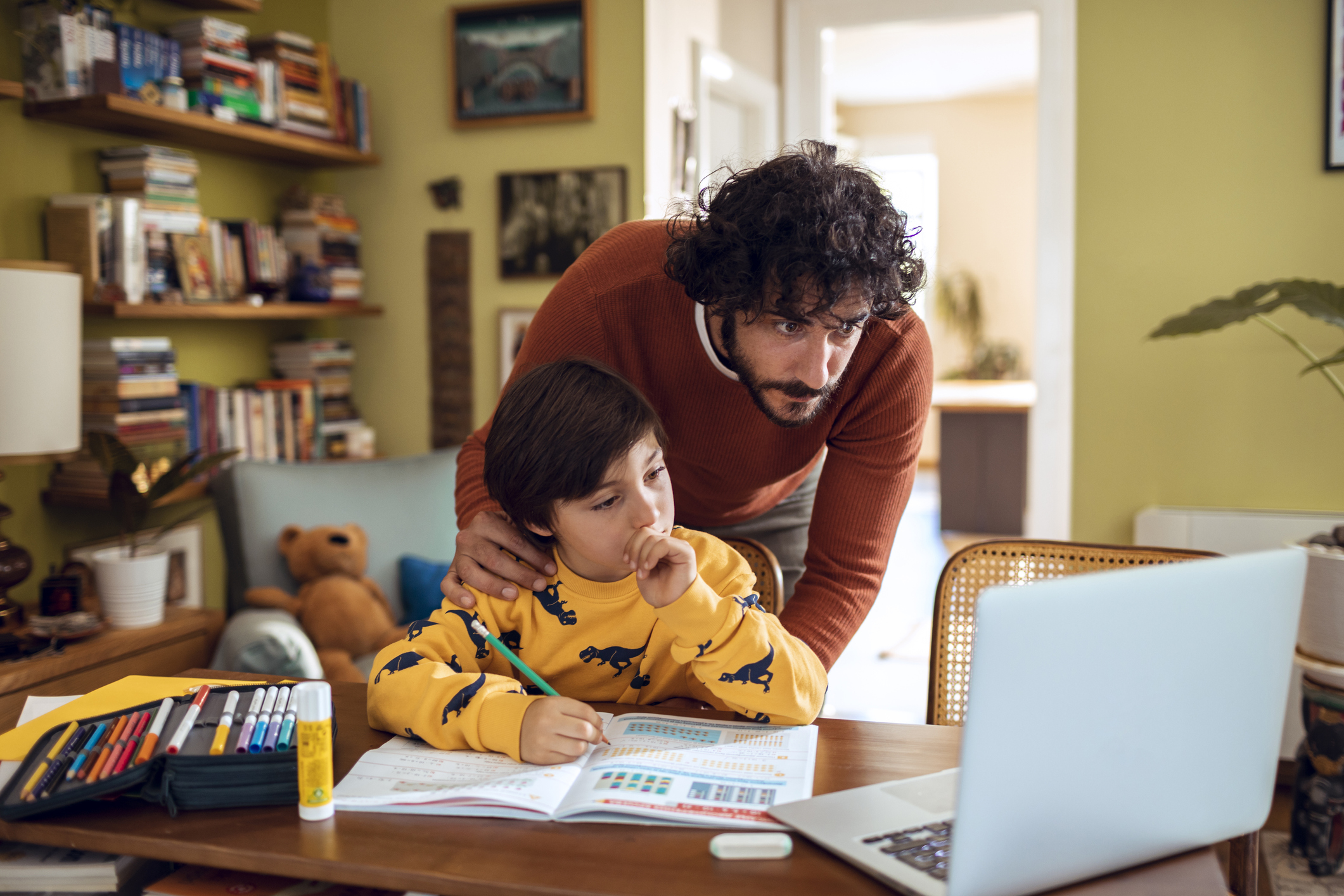As many parents across the country face the reality that their kids will be learning remotely, at least for the time being, anxieties continue to grow. In fact, for many parents, showing up for their jobs while helping children with homeschooling has become one of the most trying aspects of the pandemic. Often, what helps the most is hearing how other parents are navigating these challenges — or even just how they are accepting that this time will look anything but perfect, and that’s OK!
We asked our Thrive community to share with us the strategies that have helped them navigate digital learning with their kids. Which of these tips will you try this year?
Set up a focused learning space
“One lesson I’ve learned is to control the homeschooling environment. Initially, my son’s desk was set up in his playroom, which was a recipe for disaster. It is not fair to put a seven-year-old around a bunch of his favorite toys and get upset when he loses focus. We moved him into our lounge, where there are no tempting distractions. Controlling his environment meant ensuring the desk had nothing that would fight for his attention. I think of it like us putting away distracting apps and social media when working on something important.”
—Lori Milner, speaker, trainer, author, Johannesburg, South Africa
Embrace virtual social interactions
“If your kids are used to seeing grandparents, caregivers, or classmates throughout the day, keep those interactions a part of their routine, whether via FaceTime or another virtual platform. Even if that interaction only lasts for twenty minutes, it may help ease the pressure of trying to keep them engaged and entertained all by yourself. I’ve found it helpful to have a relative read a story over the phone. Perhaps you could have your child learn a second language with a neighbor, or even have a virtual dance party with friends. It’s the little things that go a long way, and helps homeschooling life not feel so closed in.”
—Antonette M., pediatric nurse practitioner, S.C.
Make time for fresh air
“When we moved to an online method of learning at the start of the pandemic, I tried to build as much fun and outdoor time as I could into our daily structure. My two sons are used to playing sports and having a lot of activity during the day, so as time went on, I saw that getting outside to be in the fresh air was a game-changer for their learning. Every Sunday, I would map out a weekly schedule that included their time at their desk learning, and ample breaks for walks, hikes, biking and other outdoor adventures. Fresh air makes learning and life feel better.”
—Emily Madill, author and certified professional coach, Nanaimo, B.C., Canada
Give your kids (and yourself!) a break
“While keeping a daily schedule that promotes online learning is noble, it shouldn’t come at the expense of a frustrated household. During this time, I’ve learned that it’s okay to give our kids — and ourselves — a break. Work to find ways to engage the kids, but don’t give yourself too much grief if the plan isn’t executed flawlessly. Kids might miss some math or science lessons, but if they learn about stress management, prioritization and staying calm, those skills will serve them just as well in the grand scheme of things. I’ve learned that navigating digital learning is as much about setting realistic expectations as it is about achieving academic success.”
—Marta Chavent, change and management consultant, France
Choose quality over quantity
“I’ve been homeschooling my nine-year-old son since the beginning of his educational journey. The biggest lesson I learned, and what I share often, is the same one we learn in real life every day: time spent does not equate to quality. I’ve learned that children don’t need to spend a certain amount of hours a day in order to learn efficiently. It is the quality of the experience that matters most when it comes to educational gains.”
—Nicole Wipp, attorney and consultant, Detroit, MI and Honolulu, HI
Designate a “classroom” at home
“Your brain needs different spaces for different things, but it’s not always easy to keep the kids’ school space clean and organized, and away from distractions. I found it helpful to create a mini ‘classroom’, with a long table and a desk divider. I added larger monitors that the kids devices plug into so that Zoom calls replicate a more natural conversation with teachers than a tiny screen. I invested in noise-cancelling headphones to help them focus. I’ve also found it helpful to make sure the room has natural light, is a comfortable temperature, and is stocked with pencils, paper, and anything else the kids will need for their work.”
—Nadine Levitt, CEO and founder, Austin, TX
Prioritize bonding time
“Oftentimes, parents try to keep the stoic hierarchy of the public system into the personal space of home. As an official public school substitute myself, I can tell you that this will likely not work. The focus should not be on bringing the educational system into your home, but rather meshing into a family team. I’ve found that the most effective use of homeschooling, especially when new at it, should be to bond with your children so you can better and more effectively teach. The closer you are to your children, the easier it is to learn from you as their parent.”
—Mike Fox, CEO of Splash Designworks and public speaker, Milford, DE
Think beyond typical schoolwork
“As a mom of three, I’ve learned that there is so much more to education and learning than schoolwork. A great tip is to zoom out and appreciate that this time can be used for more expansive learning beyond the traditional (or online) school setting. Younger kids can explore newfound confidence by being more involved with independent play, baking, and taking care of the home. Older kids can level up their leadership skills by taking charge of dinner preparation or organizing a mini homeschool-style camp. This is our chance to embrace the chaos of the unknown and make this time something purposeful, and uniquely our own.”
—Leisse Wilcox, transformational mindset and success coach, Toronto, ON, Canada
What’s one lesson you’ve learned from homeschooling your kids? Share it with us in the comments.
Follow us here and subscribe here for all the latest news on how you can keep Thriving.
Stay up to date or catch-up on all our podcasts with Arianna Huffington here.


